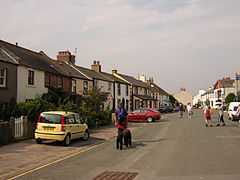Ravenglass
| Ravenglass | |
 View up Main Street |
|
 Ravenglass | |
| OS grid reference | SD0896 |
|---|---|
| Civil parish | Muncaster |
| District | Copeland (borough) |
| Shire county | Cumbria |
| Region | North West |
| Country | England |
| Sovereign state | United Kingdom |
| Post town | Ravenglass |
| Postcode district | CA18 |
| Dialling code | 01229 |
| Police | Cumbria |
| Fire | Cumbria |
| Ambulance | North West |
| EU Parliament | North West England |
| UK Parliament | Copeland |
Ravenglass is a small coastal village and natural harbour in Cumbria, England. Historically in Cumberland, it is the only coastal town in the Lake District National Park. It is located at the estuary of three rivers: the Esk, Mite and Irt.
The hamlet of Saltcoats lies north of the River Mite.
History
The town dates back to at least the 2nd century, when it was an important naval base for the Romans. The Latin name of the settlement is the subject of scholarly debate: believed by some experts to have been Tunnocellum,[1] it is often named Glannoventa. It occupied the most southerly point of the Cumbrian coastal defence system, which can be seen as an extension of Hadrian's Wall and the western extremity of the Roman frontier World Heritage Site.
Ravenglass was occupied by the Romans for over 300 years and had a garrison (castra) of 500 soldiers. The town was a regional supply point for much of north-western Roman Britain, with a road from Ravenglass over the Hardknott Pass to the Roman fort at Ambleside. The location is featured in The Fort at River's Bend, a book in Jack Whyte's A Dream of Eagles (Camulod Chronicles) series, and is also mentioned briefly in Mary Stewart's Merlin trilogy under the name Clannoventa. Today, there are few Roman remains, with the notable exception of a bath-house, known locally as Walls Castle. This is one of the largest remaining Roman structures in England, covering an area of 30 yards (27 m) by 13 yards (12 m) and with walls up to 12 feet (3.7 m) high. The property is now maintained by English Heritage.
'Renglas' appears in charters and other records of the late 12th century. In 1208 King John granted Richard de Lucy, Earl of Egremont a charter for a market at Ravenglass on Saturdays and a yearly fair on the festival of St. James, 5 August.
Attractions
Tourist attractions include Muncaster Castle and the Ravenglass and Eskdale Railway.
Access
Ravenglass is served by the A595 trunk road and Ravenglass railway station on the Cumbrian Coast railway line. It is a terminus of the Ravenglass and Eskdale Railway, a popular tourist attraction.
References
- ↑ "RAVENGLASS (Itunocelum)". Retrieved February 26, 2013.
External links
![]() Media related to Ravenglass at Wikimedia Commons
Media related to Ravenglass at Wikimedia Commons
- Ravenglass Community website
